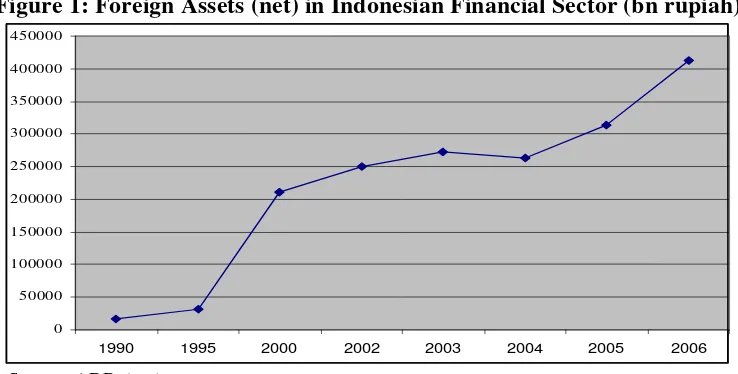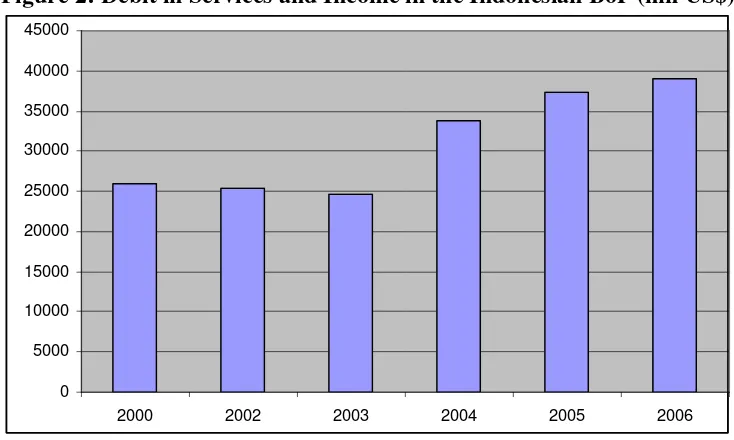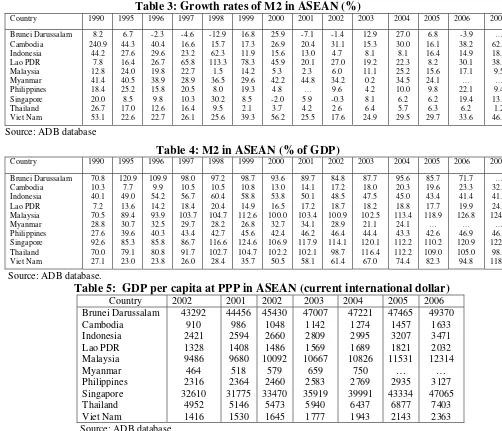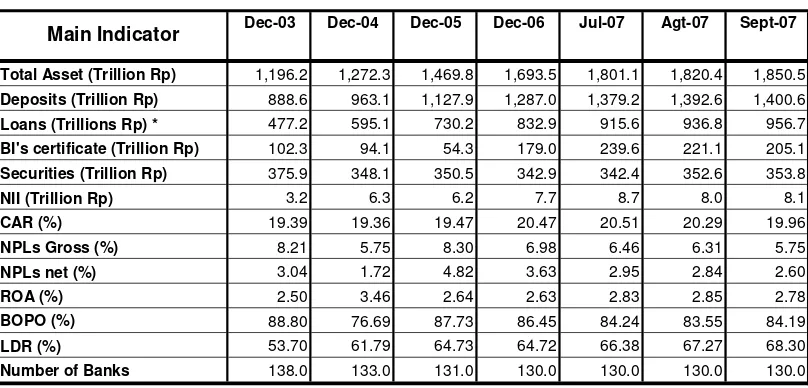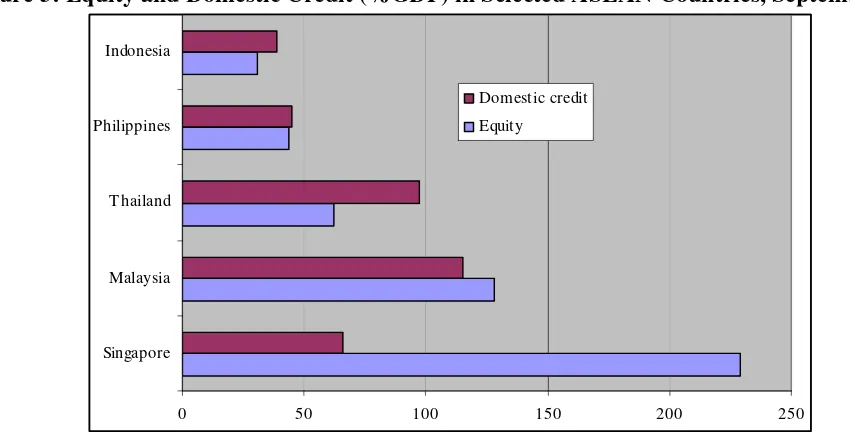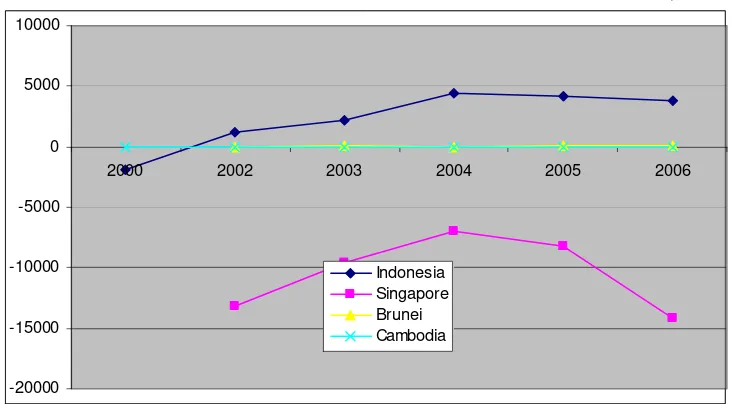Financial Services Liberalization and Integration in a Developing Region: The Case of
ASEAN
Tulus Tambunan
Center for Industry and SME Studies, University of Trisakti, Indonesia
Abstract
After the Asian financial 1997/98 crisis, ASEAN free trade area (AFTA) was extended to include regional cooperation in finance. Recently, the 10-members of ASEAN have agreed to speed up the liberalization and integration of financial services by 2015. With this recent development, the main aim of this paper is to assess the main challenges that ASEAN countries are going to counter in the near future in their efforts to speeding up the process of financial services liberalization and integration and to suggest best practices to be followed in order to achieve the objective. The paper argues that the successful of financial services liberalization and integration in ASEAN depends also on a good institutional cooperation, and this latter faces several challenges, including that economies of ASEAN are diverse and heterogeneous in terms of economic systems, per capita incomes, stages of economic and institutional development, and human and social conditions, and ASEAN countries are also diverse in political systems (e.g. Myanmar versus the rest of ASEAN, or Vietnam versus Indonesia) and in cultural and religious traditions (e.g. Indonesia and Malaysia versus Singapore and Thailand), without shared history of political integration under a hegemonic power.
JEL Classification: F36, G2
Key words: Financial services liberalization, financial services integration, challenges, best practices, ASEAN
Background
Compared with Europe, Asia is a relatively newcomer to regional integration. Before the Asian crisis,
economic integration was primarily market-led and private sector-driven. Few major government-led
cooperation initiatives existed, and those that did were limited to the areas of cross-border infrastructure and
trade. These included, for example, the ASEAN Free Trade Area, both of which were initiated in 1992.
After the 1997-98 financial crisis, however, the market-led process was supplemented by a series of
government-led initiatives. In addition, the scope of such initiatives was extended to include regional
cooperation in finance, especially in East Asia. The introduction of the ASEAN+3 economic surveillance
process, the establishment of regional resource pooling through the by now well-known Chiang Mai
Initiative (CMI), and the implementation of the Asian Bond Markets Initiative are noteworthy
achievements. Recently, the 10 members of the Association of Southeast Asian Nations (ASEAN) have
With this recent development, the main aim of this paper is to assess the main challenges that ASEAN
countries are going to counter in the near future in their efforts to speed up the process of financial services
liberalization and integration and to suggest best practices to be followed to achieve the objective.
Recent Development of the Financial Sector in the Region
While considerable disparities are observed among the ASEAN member countries affected by the crisis (i.e.
Indonesia, Thailand, the Philippines, and to a certain extent, Malaysia and Singapore) their economy
recovered at an accelerated pace from the Asian financial crisis of 1997/98. They are engaged in various
structural reform programs, including the reorganization and restructuring of the financial and corporate
sectors. While considerable progress has been achieved in these areas, banks, especially in Indonesia, have
not fully regained their functions of financial intermediation, and problems remain here. While progress has
also been made in removing non-performing loans (NPLs) from the balance sheets of banks, there are
concerns that the restructuring of corporate liabilities may be delayed. Capital markets have not developed
to the level where they can perform their market functions satisfactorily.
Market-driven financial integration in ASEAN has been underway since the crisis in 1997/98, as a result
of the increased deregulation of the financial system, opening of financial services to foreign institutions,
and liberalization of the capital account in member countries. Active commercial bank loans and portfolio
investment flows have begun to link the economies in the region financially. Financial integration has yet to
deepen through greater policy efforts to further deregulate impediments to the market based functioning of
national capital markets and to harmonize market infrastructure and regulatory frameworks. As a result of
market-driven economic integration, macroeconomic interdependence within ASEAN has become stronger.
For instance, Kawai (2005) found from data in the 1980s and 1990s that real macroeconomic activities
(e.g. growth rates of real gross domestic product (GDP), real private consumption, and real fixed
investment) of Singapore, Malaysia and Thailand are highly correlated with each other, while they are not
strongly correlated with those of the United States or Europe. The deepening of economic linkages and
interdependence calls for institutional cooperation to manage such links and interdependence (Kawai, 2005).
However, during the 1997/98 crisis, some of the member countries experienced negative economic
growth, with Indonesia at the top with around -13 per cent, followed by Thailand at -10.5 per cent, and
Malaysia -7.4 per cent. In 1999, these adversely affected countries started to recover (Table 1). This
experience may also support the view that ASEAN economies, especially Indonesia, Malaysia, Thailand and
Singapore are indeed closely correlated. Consequently, an economic collapse in one of these countries
Table 1: Growth Rates of Real GDP in ASEAN Countries (%)
Country 1990 1995 1996 1997 1998 1999 2000 2001 2002 2003 2004 2005 2006 2007 Brunei Darussalam
As discussed before that, based on 1980s and 1990s data, Kawai (2005) found that real macroeconomic
activities, including real fixed investment, of countries within ASEAN are highly correlated with each other.
Recent data from the ASEAN Secretariat show that the investment linkages through foreign direct
investment (FDI) flows among the countries continue to increase. In 2004, the net value of FDI among them
was 2,803.7 million US$ and went up to 6,242.1 million US$ in 2006. Look at the year-on-year change, it
increased from 34.3 per cent for the period 2004-2005 to 65.8 per cent for the period 2005-2006, or the
share to total net inflow of FDI to the region increased from 8.0 per cent in 2004 to 11.9 per cent in 2006.
Of course, opening of financial services in ASEAN has enormous policy implications for
macroeconomic and financial stability, economic growth1and development of financial sector in a member country. As demonstrated by the Asian financial crisis of 1997/98, mismanagement of financial opening
may lead to disastrous economic consequences. In other words, the liberalization of financial sector per se
was not the cause of the crisis, but the management of the process and financial policies were poor. That is
why after the crisis, ASEAN governments started to speed up financial services liberalization together with
financial integration in the region to meet two main goals, namely in order to prevent the recurrence of the
Asian currency and financial crisis in 1997/982and to realize the stable economic growth. Other needs for financial services liberalization and integration in the region include: (1) re-channel regional savings into the
regional economies; (2) reduce the stock of international reserves; (3) contribute to regional financial
stability; and (4) promote intra-ASEAN trade and ASEAN monetary integration. It is generally believed that
financial services liberalization with prudent financial policies, including orderly opening and
1
For theoretical discussion and empirical evidence on the relationship between financial liberalization and economic growth, see, e.g. Rajan and Zingales (1998), Vlachos and Waldenstrom (2002) and Bekaert et al. (2001).
2
implementation of commitments under the General Agreement on Trade in Services (GATS),3can result in macroeconomic stability, sustained output growth, and financial sector development (Kim, 2000, 2002).
In Indonesia, for instance, efforts to liberalize financial sector in Indonesia in a gradual way from the
early 1980s have shown some results.4The share of foreign and joint banks in the country has risen every year from 9.4 per cent in 1996 to 27.7 per cent in 2001. The growth rate of foreign and joint banks loans has
been higher than that of domestic banks at the time the Indonesian economy was hit by the crisis in 1997/98,
foreign capital flows, both direct and indirect (portfolio), reversed, and enormous financial and corporate
restructuring efforts were made. This pattern notes that foreign banks’ lending was more countercyclical and
stable than that of domestic banks, contributing to financial and economic recovery and private sector
investment. Sector lending performance indicates that the share of foreign banks’ loans to manufacturing
has steadily increased in the post-1997/98 crisis period but the services and trade sectors suffered a sharp
decline in the same period. Foreign banks should have also contributed to manufacture of goods for exports
and employment opportunities. Another positive result of liberalization of domestic financial sector is the
significant increase of foreign assets in the sector, which started significantly since the beginning of 1990s.
As shown in Figure 1, in 1990 total foreign assets (net) were slightly more than 16 trillion rupiah, and
reached at more than 413 trillion rupiah in 2006.
Figure 1: Foreign Assets (net) in Indonesian Financial Sector (bn rupiah)
0 50000 100000 150000 200000 250000 300000 350000 400000 450000
1990 1995 2000 2002 2003 2004 2005 2006
Source: ADB database
3
Financial service is a major component of GATS. GATS covers virtually all of the world trade in financial services. Four (4) different models of financial services trade identified by GATS: cross-border (mode 1); consumption abroad (mode 2): commercial presence (mode 3); and presence of natural persons (mode 4).
4
If financial liberalization in Indonesia generates more foreign financial services operate in Indonesian
market, then, the growth of invisible imports, that is, earnings by foreign countries from selling financial
services within Indonesia plus interest paid on investments in Indonesia by overseas countries can also be
used as an indicator to assess the success of opening Indonesian financial market. These foreign earnings
and interest payments are included in the debit side of services and income in the Indonesian balance of
payments (BoP), which increased from 26046 million US dollar in 2000 to 38937 million US dollar in 2006
(Figure 2).
Figure 2: Debit in Services and Income in the Indonesian BoP (mn US$)
0 5000 10000 15000 20000 25000 30000 35000 40000 45000
2000 2002 2003 2004 2005 2006
Source: ADB database
In Malaysia, another example, the share of foreign banks’ lending in total lending has been stable at
23-24 per cent but increased steadily year by year since the 1997/98 financial crisis. The rate of increase of
foreign banks’ lending appears to be slightly higher than that of domestic banks since the crisis. Foreign
banks in Malaysia did not cut down their lending after the crisis, rather, showed a countercyclical lending
pattern that must have contributed to the country’s economic recovery, employment creation, and financial
stabilization in this period.
Annual growth in domestic saving is also a good indicator of good development of domestic
financial/banking sector. Theoretically, financial services liberalization is expected to lead to more efficient
and stable domestic financial system, and the later, in its turn, encourage people to save their money in
banks if not invested it in capital market, and, so, domestic saving increases. As an empirical illustration,
based on data from Asian Development Bank (ADB), Table 2 shows that gross domestic saving as a
percentage of GDP (at current market prices) in Indonesia is still relatively lower than that in, for instance,
source of saving) in Indonesia is still lower than that in Singapore. However, this may also due to the fact
that the degree of soundness of financial sector in Indonesia, which was hit hard during the 1997/98 crisis,
is still lower than that in Singapore.
Table 2: Gross Domestic Saving in ASEAN (per cent of GDP)
Country 1990 1995 1996 1997 1998 1999 2000 2001 2002 2003 2004 2005 2006 2007 Brunei Darussalam
Source: ADB database
Sound banking system encourages the increase in demand and time deposits or quasi-money, which
leads to the increase in broad money supply (M2). Theoretically, the better domestic financial sector,
accompanied with the higher income per capita, the higher the growth of M2 is as well as the higher M2 as a
percentage of GDP is (financial sector depth). This is well evident in the combination of Tables 3, 4, and 5.
For example, higher ratios in Singapore, Malaysia and Thailand (as the most leading economies in the
region) with much lower ratios in Indonesia (middle level developed/income country) and Cambodia (low
income country). In those three countries, income per capita is higher than that in Indonesia, reflecting that
their levels of economic development are higher that that in Indonesia.
However, the opening of financial services in ASEAN countries has been relatively limited (even under
ASEAN Framework Agreement on Services, AFAS). Thus, financial services liberalization is a big indeed
challenge to the ASEAN countries, especially Indonesia, Thailand, Malaysia and Singapore, as the most
developed economies as compared to the rest of other member countries. According to Lee (2007),
financial integration in Asia (including ASEAN) is still weak. The main reasons the followings: (a) low
incentives for portfolio diversification within the region; (b) low degree of development and deregulation of
financial markets (although the degree may vary by country); (c) instability in monetary and exchange rate
regimes; and (d) dominance of global “foreign” players, especially from the United States (US) and
European Union (EU). In addition to these reasons, others such as (e) administered low nominal interest
rates, often resulting in negative real rates; (f) low ratios of real money to national income; (g) small and
oligopolistic financial sectors (relative to the size of the economy) dominated by intermediation in
short-term financial assets; (h) dual economies with capital-intensive modern sectors served by cheap foreign
finance; and (i) large government deficits that pre-empted the resources of the formal financial sector and
generated inflation (by inducing excess money creation), at least in some, less developed member countries
could also play an important role.5
Table 3: Growth rates of M2 in ASEAN (%)
Country 1990 1995 1996 1997 1998 1999 2000 2001 2002 2003 2004 2005 2006 2007 Brunei Darussalam
Source: ADB database
Table 4: M2 in ASEAN (% of GDP)
Country 1990 1995 1996 1997 1998 1999 2000 2001 2002 2003 2004 2005 2006 2007 Brunei Darussalam
Table 5: GDP per capita at PPP in ASEAN (current international dollar)
Country 2002 2001 2002 2003 2004 2005 2006
In addition, Stiglitz (1994) suggested that seven market failures are pervasive in financial markets,
which can be as serious constraints to the smooth process of further financial liberalization: (a). monitoring
of the financial system as a public good; (b).externalities of monitoring selection and lending; (c)
externalities of financial disruptions; (d) missing and incomplete credit and insurance markets; (e)
imperfect competition; (f) failure to meet the information criteria for efficient competitive markets; and (g)
the behavior of uninformed investors;
5
Some Main Challenges Ahead
Liberalization or opening of financial services is often referred to as “internationalization” of the financial
sector, involves the establishment and operation of foreign-owned financial institutions in the domestic
market, providing services in competition with domestic players.6It is therefore a form of foreign direct
investment. Although opening of financial services is closely associated with capital account liberalization,
as in the context of WTO, ASEAN negotiations on financial services liberalization are not concerned with
capital account liberalization; foreign companies allowed to provide financial services will be subject to
capital controls in force.7
According to Shaw (1973), among others, financial liberalization meant: (a) market-determined
interest rates; (b) greater ease of entry into the banking sector to encourage competition; (c) the
elimination of directed credit programs; (d) reduced fiscal dependence of the state on credit from the
banking system (to allow for greater expansion of credit to the private sector); (e) the integration of formal
and informal markets; (f) a movement towards equilibrium exchange rates and, eventually, flexible
exchange rate regimes with open capital accounts.
In the context of global trade liberalization, every country faces two main challenges: can domestic
made products compete with imported similar products and can domestic made products be exported. In the
context of global investment liberalization, the challenges are: can domestic industries compete with
foreign direct investment-based companies and can domestic industries expand their activities abroad. In
the context of financial services liberalization and integration in ASEAN, the challenges are similar: can
domestic banks compete with foreign-owned financial institutions and can domestic banks operate abroad.
In other words, whether financial services liberalization and integration in ASEAN will give benefits to all
member countries, it depends on whether individual countries are able to meet those two challenges.
In addition to those two challenges, there is another challenge: how can, say, Indonesia, compete with
other ASEAN countries to attract foreign direct investment in financial sector from other ASEAN
countries, since Indonesia may benefit from banking, insurance and securities companies from more
developed ASEAN countries (e.g. Singapore),8as: (1) they are able to provide more outlets for domestic
6
The justifications for policies of financial liberalization find their initial expression in the propositions contained in the independent (and nearly simultaneous) publications of Ronald McKinnon (1973) and Edward Shaw (1973). These propositions, taken together, have since become known as the McKinnon-Shaw hypothesis or the financial liberalization thesis.
7
The most noteworthy about financial services liberalization is the opening of domestic financial sector which is often accompanied by capital account and banking liberalization. On the other hand, financial crises in most cases (as with the Asian financial crisis in 1997/98) are often associated with capital account and banking liberalization. Or, the main reason for such crises not the liberalization of domestic financial sector as such, but due to wrong adopted sequences of liberalization measures. 8
savings; (2) increase the capacity of the domestic financial services market through enhanced competition
and managerial efficiency; (3) with better developed foreign-owned financial institutes, domestic financial
services market is better able to withstand the effects of financial instability; (4) foreign financial
institutions bring with them new capital to provide financing for infrastructure and other long-term projects
development by recycling domestic and foreign savings (low capital cost especially for long-term
investment); (5) they are able to help recapitalize the domestic banks’ capital base by purchasing ailing
domestic institutions, in particular, during the crisis period; (6) in circumstances where domestic
institutions are burdened by NPLs and assets, foreign banks may be able to maintain the flow of credits to
industry; (7) the competition effects of new financial services institutions should also bring with it
consumer gains (in terms of consumption smoothing, risk diversification, and lower transaction costs as
their presence facilitates economies of scale and reduces price markups); and (8) foreign financial
institutions that enter into partnerships with local companies can train local staff and provide know-how.
Knowledge spillovers take place when employees move to other domestic financial institutions (Wang,
2002; Lee, 2007).
No doubt that for gaining benefits of financial services liberalization and integration in ASEAN, local
financial institutions in, say, Indonesia, must be able to compete with financial institutions in other ASEAN
countries, and for that Indonesia must develop an efficient and stable financial system. To have this, many
necessary factors should be in place, including good governance and transparency should be ensured.
Financial services liberalization efforts should also be pursued with a view to (1) encourage market
competition, (2) mobilize foreign direct investment (FDI), and (3) maintain financial market stability.
Within this context, Asian Development Bank (ADB) in its Fourth Asian Development Forum in 2002
made several policy recommendations, including sequencing of liberalization, formulation of appropriate
regulatory and macroeconomic frameworks, focus on commercial presence in the liberalization process,
and gradual opening of equity markets.9
However, successful of financial services liberalization and integration in ASEAN depends also on a
good institutional cooperation, and this latter faces several challenges. First, economies of ASEAN are
diverse and heterogeneous in terms of economic systems, per capita incomes, stages of economic and
institutional development, and human and social conditions. Diversity and heterogeneity imply that
low-income member countries (e.g. Lao PDR, Cambodia, Myanmar and Vietnam), where market infrastructure
is insufficiently developed and institutional capacities are limited, will be slow in trade, investment and
financial liberalization and market opening and, hence, will not be able to integrate themselves quickly with
9
the rest of ASEAN. This constitutes an obvious impediment to financial services integration for the whole
of the region. For the governments of member countries to take joint action at the regional level, there must
be substantial economic convergence. Second, ASEAN countries are also diverse in political systems (e.g.
Myanmar versus the rest of ASEAN, or Vietnam versus Indonesia) and in cultural and religious traditions
(e.g. Indonesia and Malaysia versus Singapore and Thailand), without shared history of political integration
under a hegemonic power. As a result, establishment of a common value, mutual trust or strong political
will for financial services (or economic in general) integration is one of ASEAN’s most challenging
issues.10
Besides the above critical factors that need to be taken into account, macroeconomic stability prior to
liberalization is also very important.11Financial liberalization is an extremely important component of a successful development strategy. This means that if financial deregulation is implemented in isolation, it is
unlikely to promote growth and may, in fact, impede economic development. Macroeconomic stability
must be accompanied with structural reform and institutional development in the financial sector, especially
prudential financial supervision, are equally essential as liberalization proceeds.
Finally, measuring the results of financial reform/liberalization is extremely important if policy is to be
well designed and implemented. The effects of financial liberalization itself may distort the inferences
drawn from conventional measures of financial deepening about the success of reform. Consequently, a
wide range of performance indicators should be monitored by policymakers. This is especially important in
member countries, where conventional measures may exaggerate the success of countries' reform programs
in their early stages and thereby obscure underlying problems (notably, fiscal imbalances) that will require
attention if financial reform is to be successful in the medium term
Looking for the Best Development Strategy
Since domestic conditions vary by member country, it is not easy to have a common formula or blueprint to
develop efficient and stable financial systems. However, a combination of many experiences in many other
10
A brighter side is that the ASEAN countries do share the view that “peace and security” is the basis for sustained economic growth and development. From this perspective, Indonesia, Malaysia, Thailand, and other ASEAN countries have so much to gain from their good political relationship, without which the region cannot make substantial progress on economic integration. 11
countries which now have well developed financial systems may give an idea about best practices (EG,
2002). First, establishing a sound banking system trough the following measures: (a) the function of the
banking sectors should be strengthened and the capital markets should be develop. For this purpose, it is
important to establish an economically rational division of functions between local and foreign banks,
between private and public financial institutions, and between the banking sector and the securities market.
This division of functions must be designed to draw out the merits of each component part; (b) solving
problem of non-performing loans (NPLs) and their disposal must be proceed smoothly. For instance, in
Indonesia, although series of measures have been implemented, including the disposal of non-performing
loans, recapitalization, consolidation and dissolution of banks, non-performing loans have been eliminated
from the balance sheets of banks and transferred to asset management companies, the final disposal of
non-performing loans is not proceeding smoothly. Table 6 shows that in the region, at least among member
countries where data are available, Indonesia is the biggest country with the NPL problem. However, the
banking sector in Indonesia has been in a good tract in solving its NPL problem, as also shown in more
detail in Table 7; (c) supervisory and regulatory frameworks should be reinforced. Since the 1997/98 crisis,
Indonesia, for instance, has been strengthening their prudential regulations.12However, not only in Indonesia but also in some other ASEAN countries, considerable room for improvement remains, especially in
rationalization and reduction of policy intervention in the financial system; easing of entry restrictions on
foreign banks in accordance with the stage of financial development; reform of the ownership structure of
banks; adoption of higher standards of statutory disclosure, arrangements for the early exit of failed banks,
and the development of operational rules which conform to international standards and principles, as well as
to the domestic conditions of individual countries. On the other hand, in response to the liberalization and
integration of finance sector, banking audit must target the international consolidated operations of banks;
(d) good governance in banking must be established as it is an essential factor in the development of sound
financial systems. For this purpose, banks must be independent of government policies and must not be the
"institutionalized banks" of corporate groups as was the case in Indonesia before the crisis; and (e) local
banks must be revitalized, and especially for small banks this can be done with the consolidation of through
e.g. mergers. This is one way to improve the competitive position of local banks, as it increases economies
12
of scale, and thus with this way it is hope that local, especially small banks can survive in a process of
liberalization and integration. Although in many countries, including Indonesia, the corporate lending
activities of local, especially small banks, have declined in total due to the full-fledged entry of foreign
banks subsequent to the easing of regulations, local banks still have a crucial role to play, namely in
financing the development of small and medium enterprises (SMEs) which in all ASEAN countries
constitute the foundation of domestic industries (Tambunan, 2006). And, since the majority of SMEs in
countries such as Indonesia, Thailand and the Philippines are located in rural areas, local or especially small
banks have opportunities to grow in rural areas. Other ways to strengthen local banks are through
strengthening the monitoring function of local banks; development of an environment for autonomous and
efficient bank management which is independent of intervention by government and corporate groups;
improvement of human resources; reform of management structures; and, further promotion of information
disclosure.
Table 6: Bank nonperforming loans in ASEAN (% of total gross loans)
Country 2000 2001 2002 2003 2004 2005 2006 2007
Table 7: Recent Development of Banking Sector in Indonesia
Dec-03 Dec-04 Dec-05 Dec-06 Jul-07 Agt-07 Sept-07
Total Asset (Trillion Rp 196.2 ,272.3 ,469.8 ,693.5 1,801.1 1,820.4 1,850.5 eposits (Trillion Rp) 888.6 963.1 1,127.9 1,287.0 1,379.2 1,392.6 1,400.6 ns (Trillions Rp) * 477.2 595.1 730.2 832.9 915.6 936.8 956.7 I's certificate (Trillion Rp) 102.3 94.1 54.3 179.0 239.6 221.1 205.1 curities (Trillion Rp) 375.9 348.1 350.5 342.9 342.4 352.6 353.8
II (Trillion Rp) 3.2 6.3 6.2 7.7 8.7 8.0 8.1
R (%) 19.39 19.36 19.47 20.47 20.51 20.29 19.96
Gross (%) 8.21 5.75 8.30 6.98 6.46 6.31 5.75
net (%) 3.04 1.72 4.82 3.63 2.95 2.84 2.60
(%) 2.50 3.46 2.64 2.63 2.83 2.85 2.78
BOPO (%) 88.80 76.69 87.73 86.45 84.24 83.55 84.19
LDR (%) 53.70 61.79 64.73 64.72 66.38 67.27 68.30
ber of Banks 138.0 133.0 131.0 130.0 130.0 130.0 130.0
Second, improving long-term funding mechanisms. This should be done through heightening the
capability of domestic financial systems to supply long-term credit. For this end, large pools of domestic
savings must be sustained, which, if properly utilized, can finance the necessary investments for achieving
high economic growth rates. Tables 8 and 9 show development of gross capital formation in the region.
Thus, the capability of domestic financial systems to supply long-term credit maintains high levels of
sustained economic growth without becoming excessively dependent on foreign funds. For this purpose,
further steps should be taken: (1) the procurement of investment funds based on market mechanisms, as well
as to work towards strengthening of market mechanisms must be promoted; (2) the capability of local banks
to supply long-term credit should be heightened. For this purpose, the following lines of action are
important: (2a) development of an environment conducive to the supply of long-term credit by banks, (2b)
improvement of risk-management and maturity formation-capacities, (2c) boosting of bank capitalization,
(2d) use of syndicated loans and other risk-reducing methods, and (2e) promoting the entry of foreign banks
with the ability to accept higher risk burdens; (3) systems for direct procurement of long-term funds from
investors through the issue of corporate bonds should be strengthened;13and (4) development of the systemic infrastructure.14
Table 8: Gross Domestic Capital Formation in ASEAN (% of GDP)
Country 1990 1995 1996 1997 1998 1999 2000 2001 2002 2003 2004 2005 2006 2007 Brunei Darussalam
Source: ADB database
Third, developing transparent and fair capital markets. While the banking sector is expected to continue
playing a central role in ASEAN countries, when financial development reaches a certain stage, the proper
growth of capital markets becomes indispensable from the perspective of promoting the effective use of
savings. Recent development of capital markets in the region (in selected countries), reflected by the growth
in the share of equity versus the share of domestic credits in GDP, are shown in Figure 3, and the growth of
13
Because banks hold a dominant position in the financial systems of ASEAN countries, in the early stages of this process, it is important to utilize credit-evaluation function of banks to generate information on borrowers. While the provision of bank guarantees on corporate bonds is a possible approach, such measures as loan participation and loan securitization should be more effective (EG, 2002, p.4).
14
portfolio investment, another indicator of development of capital market, in Indonesia and some other
countries as a comparison (Singapore, Brunei, Cambodia) is shown in Figure 4. The proper function of
capital markets depends on their efficiency (appropriate pricing function and the ability to facilitate the
transfer of risks and maturities), and fairness (transparency in price formation and transaction process, equal
opportunity for market participation). In an effort to develop transparent and fair capital markets, the
following matters should be considered concerning the development of the ASEAN capital markets. First,
the diverse possibilities of complementarity between the financial system and the banking sector should be
considered, while taking into account the diversity in the developmental stages and financial structures of
financial systems. Secondly, attention must be paid to create transparent and fair markets capable of
winning the confidence of overseas investors.
Table 9: Growth Rates of Real Gross Domestic Capital Formation in ASEAN (% of GDP)
Country 1990 1995 1996 1997 1998 1999 2000 2001 2002 2003 2004 2005 2006 2007 Brunei Darussalam
Source: ADB database
Figure 3: Equity and Domestic Credit (%GDP) in Selected ASEAN Countries, September 2006
0 50 100 150 200 250
The challenges facing the ASEAN (or Asia in general) capital markets can be summarized as the followings
(EG, 2002, p6-7): a) the development of government bond markets represents an urgent issue from the
foundation for corporate bond markets; b) to avoid excessive dependence on banks and to promote the
stable transfer of long-term funds, it is necessary to promote the development of corporate bond markets
and to promote bond ownership by a large population of general investors. There is the view that the
participation of banks in the issue of bonds can reduce the information gap and contribute to the smooth
expansion of the bond market. However, if the capital-market operations of banks are to be conducted
through their internal organizations, it is important to erect firewalls to separate these operations from other
banking functions; c) investment banks have an important role to play as market intermediaries from the
perspective of promoting the development of capital markets in line with the stages of economic
development and financial structure. It is probably necessary to utilize foreign investment banks to launch
new capital markets; d) from the perspectives of autonomy in asset management and corporate governance,
and to perform those functions which are expected of institutional investors, it will be necessary to develop
an asset-management industry in the private sector; e) the presence of foreign investors can contribute to
promoting the vitalization of the market and achieving greater transparency. Cross-regional listing can
improve corporate disclosure and corporate governance and can also have a complementary effect on
augmenting the function of home markets and heightening possibilities for the expansion of regional
markets.
Figure 4: Growth of Portfolio Investment in Selected ASEAN Countries (mn US$; net)
-20000 -15000 -10000 -5000 0 5000 10000
2000 2002 2003 2004 2005 2006
Indonesia Singapore Brunei Cambodia
References
ADB (2002), “Fourth Asian Development Forum on Trade and Poverty Reduction”, Proceedings, December, Manila: Asian Development Bank.
Bekaert Geert, Harvey Campbell and Lundblad Chirstian (2001) “Does Financial Liberalization Spur Growth?”, NBER Working Paper, No 8245, Washington, D.C.
EG (2002), “Responding to the Challenges of the Asian Economy and Financial Markets – Crisis Prevention and Realization of Stable Economic Growth – “, the Expert Group on the Challenges of the Asian Economy and Financial Markets, Council on Customs, Tariff, Foreign Exchange and Other Transactions Subcouncil on Foreign Exchange and Other Transactions, July, Tokyo.
Husnan, Saud (2001), “Indonesia”, in Juzhong Zhuang, David Edwards, MA. Virginita A. Capulong (eds.),
Corporate Governance and Finance in East Asia. A Study of Indonesia, Republic of Korea, Malaysia, Philippines, and Thailand, Volume Two Country Studies, Manila: Asian Development Bank.
Kawai, Masahiro (2005), “Asian Economic Integration: Progress, Challenges and Opportunities”, paper presented at the Asian Economies Speaker Series, Asia-Pacific Foundation of Canada, October, Vancouver.
Kim, Yun-Hwan (2000), “Post-Crisis Policy Agenda for Reforming the Financial Sector in Asia,” in ADB and OECD, in Sustainable Recovery in Asia – Mobilizing Resource for Development, Manila and Paris: Asian Development Bank and the Organisation for Economic Cooperation and Development.
Kim, Yun-Hwan (2002), Financial Opening under the WTO Agreement in Selected Asian Countries: Progress and Issues”, ERD Working Paper No. 24, September, Manila: Asian Development Bank.
Lee, Jong-Wha (2007), “Competition and Integration – Financial Centers and Financial Market Integration in Asia”, power point material, October, Office of Regional Economic Integration, Asian Development Bank, Seoul.
McKinnon, Ronald I. (1973), Money and Capital in Economic Development, Washington, D.C.: The Brookings Institution.
Pill, Huw and Mahmood Pradhan (1995), "Financial Indicators and Financial Change in Africa and Asia," IMF Working Paper No. 95/123, November, Washington, D.C.: International Monetary Fund.
Rajan, Raghuram and Luigi Zingales (1998) “Financial Dependence and Growth”, American Economic Review, 88: 559-586.
Shaw, Edward (1973), Financial Deepening in Economic Development, New York: Oxford University Press.
Stiglitz, Joseph E. (1994). “The role of the State in Financial Markets,” proceedings of the World Bank Annual Conference on Development Economics 1993, Washington D.C.: The World Bank.
Tambunan, Tulus T.H. (2006), Development of Small & Medium Enterprises in Indonesia from the Asia-Pacific Perspective, LPFE-Usakti, Jakarta.
Vlachos, Jonas and Waldenstrom, Daniel (2002),“International Financial Liberalization and Industry Growth,” Working Paper, No. 586, The Research Institute of Industrial Economics.

